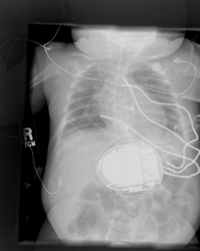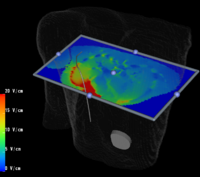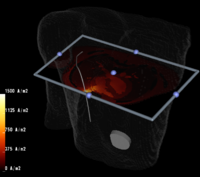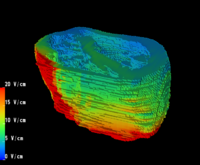Difference between revisions of "NA-MIC Childrens Collaboration"
| Line 1: | Line 1: | ||
| − | + | Back to [[NA-MIC_External_Collaborations]] | |
{| | {| | ||
| Line 29: | Line 29: | ||
=== Building and Running SCIRun on SPL Machines === | === Building and Running SCIRun on SPL Machines === | ||
[[SCRun on SPL Machines]] | [[SCRun on SPL Machines]] | ||
| + | |||
| + | === Citations === | ||
| + | |||
| + | 1. Jolley M, Stinstra J, Weinstein D, et al. Open-Source Environment for Interactive Finite Element Modeling of Optimal ICD Electrode Placement Functional Imaging and Modeling of the Heart, Lecture Notes in Computer Science. Berlin/Heidelberg: Springer, 2007:373-382. (Paper) | ||
| + | 2. Jolley M, Stinstra J, Weinsten D, et al. Finite Element Modeling of Novel Defibrillation Approaches in Children and Adult Heart Rhythm Society. Denver, Colorado, 2007. (Abstract Oral Presentation) | ||
| + | 3. Jolley M, Triedman J, Westin CF, et al. Image based modeling of defibrillation in children. Conf Proc IEEE Eng Med Biol Soc 2006;1:2564-7. (Paper and Presentation) | ||
| + | 4. Stinstra JG, Jolley M, Callahan M, et al. Evaluation of different meshing algorithms in the computation of defibrillation thresholds in children. Conf Proc IEEE Eng Med Biol Soc 2007;1:1422-5. (Paper and Presentation) | ||
| + | 5. A Computer Modeling Tool for Comparing Novel ICD Electrode Orientations in Children and Adults. In Press Accepted Manuscript for Heart Rhythm, Available online 18 January 2008, | ||
Revision as of 09:20, 23 January 2008
Home < NA-MIC Childrens CollaborationBack to NA-MIC_External_Collaborations
 
|
 
|
Contents
Introduction
Placement of Implantable Cardiac Defibrillators(ICDs)is a unique and challenging problem for children due to the variety of shapes and sizes, ranging from neonate to adolescent. As a result, a variety of novel implant techniques have been employed. Although these have generally been successful inasmuch as they result in a clinically acceptable defibrillation threshold, nothing is known about the mechanisms by which this threshold is attained, the optimal geometries for defibrillation, and whether unsafe electric field strengths are a result of novel implant approaches. Finite element modeling has been shown in adult torso models to correlate well with clinical results. Our goal is to model defibrillation in child torso models to gain insight into this important problem. We are also interested in developing new orientations in adults with the goal of lowering DFTs and providing options in patients with contraindications to standard techniques.
Goals of Project
1. Create 3D models of children based on CT and MRI datasets for modeling internal and external defibrillation in the SCIRun environment. The processes required address the larger question of how to take any CT or MRI DICOM dataset, segment it into various label maps, combine those label maps in a hierarchical manner, then import and utilize them in the SCIRun/BioPSE environment. This represents part of an expanding collaboration between SCI and SPL to integrate open source tools to allow creation, visualization, and computational modeling of image based 3D models.
2. Create modules which allow insertion of electrode shapes into finite element models in in the SCIRun environment.
3. Utilize the above innovations to model the placement of internal defibrillator electrodes to maximize efficacy, minimize potential cardiac damage, and gain further insight into optimizing defibrillation in children of various sizes as shown above.
Slicer and SPL Tools in the Project
Outline of Torso Segmentation Problem
Segmentation Tools Currently Utilized
Tools In Development and Wishlist
Building and Running SCIRun on SPL Machines
Citations
1. Jolley M, Stinstra J, Weinstein D, et al. Open-Source Environment for Interactive Finite Element Modeling of Optimal ICD Electrode Placement Functional Imaging and Modeling of the Heart, Lecture Notes in Computer Science. Berlin/Heidelberg: Springer, 2007:373-382. (Paper) 2. Jolley M, Stinstra J, Weinsten D, et al. Finite Element Modeling of Novel Defibrillation Approaches in Children and Adult Heart Rhythm Society. Denver, Colorado, 2007. (Abstract Oral Presentation) 3. Jolley M, Triedman J, Westin CF, et al. Image based modeling of defibrillation in children. Conf Proc IEEE Eng Med Biol Soc 2006;1:2564-7. (Paper and Presentation) 4. Stinstra JG, Jolley M, Callahan M, et al. Evaluation of different meshing algorithms in the computation of defibrillation thresholds in children. Conf Proc IEEE Eng Med Biol Soc 2007;1:1422-5. (Paper and Presentation) 5. A Computer Modeling Tool for Comparing Novel ICD Electrode Orientations in Children and Adults. In Press Accepted Manuscript for Heart Rhythm, Available online 18 January 2008,